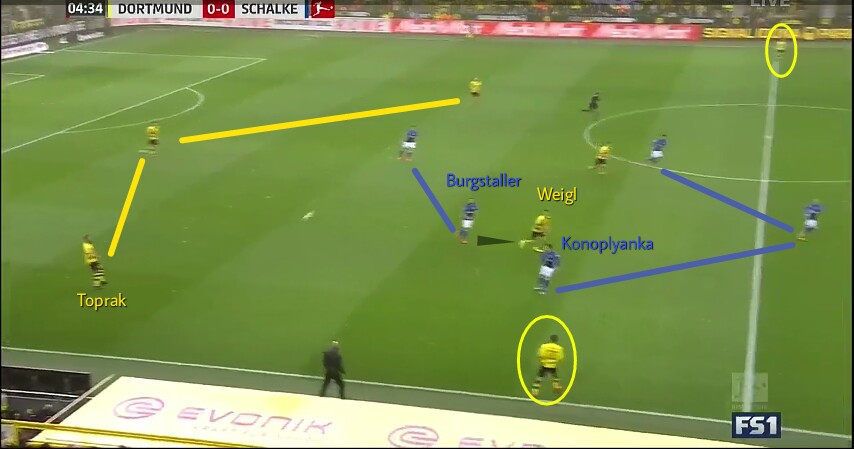This is the mother of all derbies in German football, therefore the narratives that lead to this game were full of drama and excitement: on one hand, Peter Bosz has been under pressure from the board over the past two months due to Borussia Dortmund’s slump in form, which continued during their 1-2 home loss to Tottenham Hotspur in the Champions League; on the other hand, Schalke’s new coach, Domenico Tedesco, has done very well so far in the league, as the team -reportedly- witnessed around 2000 fans during their last session of training prior to the game.
Lineups
Often criticized this season because of his tactical rigidity, Bosz surprised many by switching to a three-man defence: Christian Pulisic was shifted to a right wing back role while Pierre-Emerick Aubameyang returned to the starting XI after being left out from the squad due to disciplinary issues.
This move surprised Domenico Tedesco and Schalke, who lined up in a 3-4-3 formation: Wenston McKennie and Max Meyer started in central midfield ahead of Leon Goretzka, who had just recovered from an injury, and Amine Harit.
Borussia Dortmund (3-4-2-1): Weidenfeller; Toprak, Sokratis, Schmelzer; Pulisic, Weigl, Sahin, Guerreiro; Yarmolenko, Gotze; Aubameyang.
Schalke 04 (3-4-3): Fährmann; Stambouli, Naldo, Kehrer; Caligiuri, McKennie, Meyer, Oczipka; Di Santo, Burgstaller, Konoрlyanka.
Dortmund’s buildup and Schalke’s defensive shape
Borussia Dortmund settled in possession with a back three to initiate the first phase of buildup play; Schalke responded with a 5-3-2 defensive shape and a high, aggressive press.
Their main focus was to covershadow Weigl and deny him access on the ball, which worked quite well: Burgstaller and Konoplyanka were always coordinated in their press and they forced Dortmund to mainly play on the left flank.


Schalke’s aggressiveness (no team has committed more fouls this season) didn’t pay off though, as early bookings to McKennie and Kehrer compromised their mentality off the ball, making them more reluctant to abandon their defensive lines and close down on the opposition.
Schalke started having problems on that right flank, as Caligiuri, McKennie and Stambouli struggled to win their individual battles. The visitors’ tendency to collapse on the ball-near side was exposed in occasion of Dortmund’s first goal, when Christian Pulisic picked up the ball in space.

The hosts quickly took advantage of the momentum, adding three more goals in the space of 15 minutes (one of which was an own goal from Stambouli and another a quick counterattack lead by Aubameyang & finished by Götze).
Dortmund were creating high quality goal-scoring chances and finishing them.

Tedesco’s changes
4-nil down and with an hour of play to go, Tedesco brought on Leon Goretzka and Amine Harit in place of McKennie and Di Santo: both offered more discipline and attacking flair on that flank. Little did Tedesco know that the changes, which had seemed desperate at that stage, would have galvanized the visitors.
Second half
What happened in the following 45 minutes goes beyond any tactical masterclass.
On this website, we usually emphasize the importance of choosing the right tactics in order to get the best result possible; what Schalke managed to achieve, though, was an amazing display of mental strength: a key factor in football.
There had been indeed signs of recovery from the men in blue: Naldo’s disallowed goal and Burgstaller’s headed chance -which hit the post- are perfect examples.
Dortmund, from their own point of view, showed a bit too much complacency in letting Schalke dominate possession: the home side were now being stuck in their defensive third with Pulisic forced to track back a lot of times. Bosz’s changes were too defensive, which is not the best decision for a team lacking confidence at the back.
Goretzka and Harit’s introduction saw Schalke overturn the momentum of play in the first half and completely dominate the midfield.
Aubameyang’s sending off with 20 minutes to go (while Dortmund where leading 4-2) gave the visitors more belief: Dortmund were suffocated in their own half and were unable to even break on the counterattack.
As said before, Bosz’s substitutions didn’t help matters: Castro, who was brought on for his experience and to defend the result, immediately got booked for a stamp on Harit.
Schalke charged forward down the wings, especially the right, with Caligiuri and Harit. The equalizer, which came deep in stoppage time, was full deserved: Naldo’s thumping header (Schalke’s 11th goal from set-pieces this season) punished some terrible marking by Zagadou.
Conclusion
This was indeed a game that will live in the memories of both fans for many more years. Arguably the game of the season so far, Tedesco’s men achieved the impossible: not only did they win the second half as he had asked them to do in the dugout, but they became only the second team to achieve a four-goal comeback in the history of Bundesliga, alongside Bayern Munich in 1975.
Peter Bosz’s position is still in danger, but Bayern’s loss at Gladbach might have just saved the former Ajax manager for another week: a win at Leverkusen next week would be the only acceptable result.
On the other hand, Schalke can consider the point as important as a win despite losing the second place in the league table to the hands of RB Leipzig.
























































